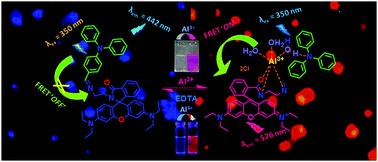当前位置:
X-MOL 学术
›
New J. Chem.
›
论文详情
Our official English website, www.x-mol.net, welcomes your
feedback! (Note: you will need to create a separate account there.)
FRET based ratiometric switch for selective sensing of Al3+ with bio-imaging in human peripheral blood mononuclear cells
New Journal of Chemistry ( IF 2.7 ) Pub Date : 2021-1-12 , DOI: 10.1039/d0nj05546h Sangita Das 1, 2, 3, 4 , Partha Pratim Das 5, 6, 7, 8 , James W. Walton 1, 2, 3, 4 , Kakali Ghoshal 9, 10, 11, 12 , Lakshman Patra 1, 12, 13, 14 , Maitree Bhattacharyya 9, 10, 11, 12
New Journal of Chemistry ( IF 2.7 ) Pub Date : 2021-1-12 , DOI: 10.1039/d0nj05546h Sangita Das 1, 2, 3, 4 , Partha Pratim Das 5, 6, 7, 8 , James W. Walton 1, 2, 3, 4 , Kakali Ghoshal 9, 10, 11, 12 , Lakshman Patra 1, 12, 13, 14 , Maitree Bhattacharyya 9, 10, 11, 12
Affiliation

|
In this work, a triphenylamine and rhodamine-B (donor–acceptor) hybrid switch (TPRH) was rationally designed, synthesised and characterised as a novel fluorescence resonance energy transfer (FRET) ratiometric fluorescent chemosensor for specific sensing of Al3+ over other important metal ions in mixed aqueous solution. We proposed that the sensor in hand (TPRH) is non-toxic and can be successfully employed to detect the Al3+ ion in human peripheral blood mononuclear cells (PBMCs), showing intracellular ‘FRET-ON’ mechanism. The orientation of the probe was designed in such a way that the fluorescence (or Förster) resonance energy transfer (FRET) proceeded from the ‘donor moiety’ triphenylamine to the ‘accepter moiety’ rhodamine-B. This fluorescent probe was found to be highly selective towards Al3+ over other important guest metal ions, including Fe3+ and Cr3+. Considering the adverse effects of Al3+ ions on human health and also on the environment, the development of sensitive and specific tools for the detection of Al3+ ions is of great value. The limit of detection (LOD) of TPRH was found to be in the order of 10−8 M. The TPRH–Al3+ complex showed reversible binding with demetallation in the presence of EDTA. In accordance with this reversibility, the fluorescence output at 576 nm from two active chemical inputs, namely, Al3+ and EDTA, followed a truth table of an INHIBIT logic gate. Moreover, cytotoxic studies found that the probe was safe to use in a biological system with good cell membrane permeability. More importantly, the bio-imaging of living human peripheral blood mononuclear cells (PBMCs) showed that TPRH could be used as an effective fluorescent probe for a prominent ratiometric in vitro detection of the transition trivalent metal ion Al3+. We evidenced a significant (p < 0.05) shift from blue to red fluorescence when Al3+ was added to the cell suspension, thus proving TPRH as a good candidate to detect intracellular Al3+.
中文翻译:

基于FRET的比例开关,用于通过生物成像选择性检测人外周血单核细胞中的Al3 +
在这项工作中,合理设计,合成并表征了三苯胺和罗丹明-B(供体-受体)混合开关(TPRH),并将其表征为一种新颖的荧光共振能量转移(FRET)比率式荧光化学传感器,可比其他重要传感器特异性地检测Al 3+。混合水溶液中的金属离子。我们建议手中的传感器(TPRH)无毒,可以成功地用于检测Al 3+ 人外周血单核细胞(PBMC)中的离子,显示出细胞内“ FRET-ON”机制。以这样的方式设计探针的方向,使得荧光(或福斯特)共振能量转移(FRET)从“供体部分”三苯胺行进到“受体部分”若丹明-B。发现该荧光探针对Al 3+的选择性高于其他重要的客体金属离子,包括Fe 3+和Cr 3+。考虑到Al 3+离子对人体健康以及对环境的不利影响,开发灵敏且专用的检测Al 3+离子的工具具有重要的价值。发现TPRH的检出限(LOD)约为10-8 M的TPRH -铝3+复合物显示可逆与EDTA的存在下脱金属结合。根据这种可逆性,两个活性化学输入(即Al 3+和EDTA)在576 nm处的荧光输出遵循INHIBIT逻辑门的真值表。此外,细胞毒性研究发现该探针可安全用于具有良好细胞膜通透性的生物系统。更重要的是,活人外周血单个核细胞(PBMC)的生物成像显示,TPRH可以用作有效的荧光探针,用于体外三价过渡金属离子Al 3+的显着比例检测。我们证明一个显著( p当将Al 3+添加到细胞悬液中时,<0.05)从蓝色荧光变为红色荧光,因此证明TPRH是检测细胞内Al 3+的良好候选者。
更新日期:2021-01-12
中文翻译:

基于FRET的比例开关,用于通过生物成像选择性检测人外周血单核细胞中的Al3 +
在这项工作中,合理设计,合成并表征了三苯胺和罗丹明-B(供体-受体)混合开关(TPRH),并将其表征为一种新颖的荧光共振能量转移(FRET)比率式荧光化学传感器,可比其他重要传感器特异性地检测Al 3+。混合水溶液中的金属离子。我们建议手中的传感器(TPRH)无毒,可以成功地用于检测Al 3+ 人外周血单核细胞(PBMC)中的离子,显示出细胞内“ FRET-ON”机制。以这样的方式设计探针的方向,使得荧光(或福斯特)共振能量转移(FRET)从“供体部分”三苯胺行进到“受体部分”若丹明-B。发现该荧光探针对Al 3+的选择性高于其他重要的客体金属离子,包括Fe 3+和Cr 3+。考虑到Al 3+离子对人体健康以及对环境的不利影响,开发灵敏且专用的检测Al 3+离子的工具具有重要的价值。发现TPRH的检出限(LOD)约为10-8 M的TPRH -铝3+复合物显示可逆与EDTA的存在下脱金属结合。根据这种可逆性,两个活性化学输入(即Al 3+和EDTA)在576 nm处的荧光输出遵循INHIBIT逻辑门的真值表。此外,细胞毒性研究发现该探针可安全用于具有良好细胞膜通透性的生物系统。更重要的是,活人外周血单个核细胞(PBMC)的生物成像显示,TPRH可以用作有效的荧光探针,用于体外三价过渡金属离子Al 3+的显着比例检测。我们证明一个显著( p当将Al 3+添加到细胞悬液中时,<0.05)从蓝色荧光变为红色荧光,因此证明TPRH是检测细胞内Al 3+的良好候选者。










































 京公网安备 11010802027423号
京公网安备 11010802027423号